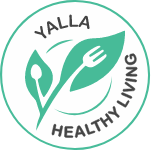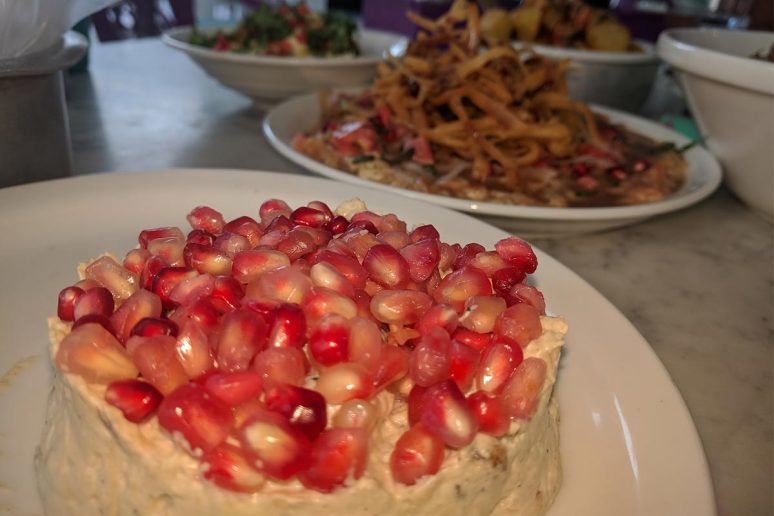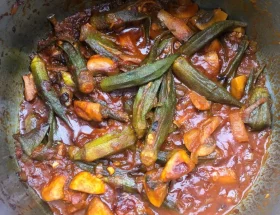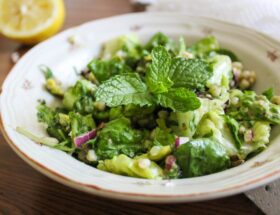If you’re traveling to a new city, and your search for vegetarian restaurants comes up empty, it’s often easy to find fantastic vegan Middle Eastern food. Middle Eastern cuisine includes restaurants that are Lebanese, Israeli, Iraqi, Iranian, or Egyptian. So use Google or Apple Maps to search for “Middle Eastern restaurants,” and if that doesn’t yield good results try, “Lebanese restaurant,” “Israeli restaurant,” and so forth. Also search for “falafel restaurants,” as these places offer delicious vegan-friendly Middle Eastern food at fast food prices.
There is no major world cuisine that’s so reliably vegan as Middle Eastern food—although that’s admittedly a surprising assertion given that most Middle Eastern restaurants have an open kitchen that prominently features a tall stack of beef or lamb slices spinning in a rotisserie. But as long as you avoid the meat dishes, traditional Middle Eastern food contains no eggs and only rarely contains dairy products.
With most other cuisines, the items that can be vegan often aren’t: the beans might contain lard, the rice might be boiled in chicken stock, or the potatoes may be cooked with butter. But with Middle Eastern cuisine, there best items on the menu are vegan nearly every time. It’s the go-to cuisine for vegans wanting to be confident that they’re avoiding animal products. Now let’s run through the most popular vegan Middle Eastern menu items.
Classic Middle Eastern Foods
The foods we’re about to cover certainly aren’t the only vegan Middle Eastern foods, but they are by far the most popular. Unless indicated otherwise, the foods we’ll review here are reliably vegan—the one exception being that Greek falafel restaurants usually add yogurt to their tahini dressing. Since many people avoid dairy products, these places will often offer a vegan tahini dressing upon request. More on tahini in a moment.
Falafel
The mainstay of Middle Eastern cooking is falafel—flavorful deep-fried balls made from garbanzo beans, garlic, and parsley. Falafel is traditionally served in either pita bread or as a wrap. The first time I ate falafel sandwich I found it so delicious that I knew I’d never want a cheeseburger again. Falafel sandwiches or wraps typically contain shredded lettuce, chopped fresh cabbage, pickled vegetables, red hot sauce (if you like spicy), and tahini dressing. If you’re unfamiliar with tahini dressing, it’s the quintessential sauce and dressing of Middle Eastern cooking. Tahini dressing is so creamy you’d swear it has milk, but unless it’s Greek-style it contains just sesame butter (tahini), water, garlic, lemon juice, and salt. Some falafel restaurants also add cheese, but that’s easy enough to avoid upon request.
Inexpensive falafel places generally use mass-market pita bread, and if they do it’s invariably the weakest component of the meal. I have nothing good to say about commercially-made pita bread. But the best restaurants bake their own pita or source it locally, and the difference is striking. Freshly-baked pita takes a falafel sandwich to the next level.
When falafel is served as a wrap, the variety of flatbread they use is called lavash. Typically they’ll put the finished wrap on a grill for a minute or so on each side, to give it grill-marks and to crisp up the lavash. If you know your restaurant offers a choice of commercially-made pita or lavash, go with the lavash since mass-produced lavash tastes pretty good, especially after being put on a grill.
Hummus & Baba Ghanouj
If you’re lucky you might also get a spoonful or two of hummus or baba ghanouj in your sandwich as well. Hummus and baba ghanouj are also commonly served as appetizers. Ordered this way, they’re served in small bowls as dips, alongside wedges of pita, sliced cucumbers, or pickled vegetable slices. Hummus is made from cooked garbanzo beans, blended until smooth with tahini, garlic, lemon juice, water, and salt. The ingredients may be dead-simple, but excellent hummus is unbelievably tasty.
Most Middle Eastern restaurants serve pickled vegetables with their hummus. The tangy crunch of pickled vegetables makes them the ideal complement to the rich flavor and smooth texture of hummus.
Baba ghanouj has a similar consistency to hummus, and it’s made from baked eggplant, combined with garlic, tahini, lemon juice and salt. One of the most reliable ways to judge a Middle Eastern restaurant is by the quality of its baba ghanouj. The best places will roast their eggplant in wood-fired ovens, which imparts a delicious smoky flavor that blends wonderfully with the garlic and tahini. It’s not traditional to do so, but a minority of restaurants add yogurt or cream to their baba ghanouj, so if there’s any doubt just ask to be sure that it’s vegan.
Dolmas, Salads, and Fries
Many Middle Eastern restaurants will offer an appetizer called dolmas—marinated grape leaves stuffed with rice, onions, and herbs. Sometimes dolmas contain meat, but even if they don’t you should ask whether they’ve been soaked in meat broth, or if the rice has been cooked in meat stock, which is sometimes the case.
If you’re looking for salad, you’re in luck. Not only do most falafel restaurants offer delicious salads made with greens, tahini dressing, and pickled vegetables, they’ll also make a much more filling grain-based salad called tabbouleh. If you rarely find salads sufficiently satisfying, be sure to give tabbouleh a try. It’s made from coarsely-ground wholegrain bulger wheat berries mixed with finely-chopped parsley and plenty of olive oil. Red ripe chopped tomatoes and finely-chopped raw onions are then added in, and the dish is seasoned with lemon juice, black pepper, and salt.
French fries obviously aren’t a traditional part of Middle Eastern cuisine, but since these restaurants invariably have a deep fryer going anyway for the falafel balls, fries are an easy addition to the menu. French fries go perfectly alongside the traditional red or orange hot sauce that’s served with falafel.
Classic Middle Eastern Garnishes
Rounding out the meal, better Middle Eastern restaurants will throw in a dish or two of kalamata olives and pickled vegetables with your order. Kalamata olives are the most popular olive in Greece. They’re a large oblong dark olive, and will usually not be pitted so be careful when biting into them. These olives are a perfect accompaniment to hummus.
Finally, watch out for tzatziki sauce, which always contains dairy. It’s made from yogurt, coarsely-chopped cucumber, and garlic. While tzatziki is not as popular as any of the previous foods we’ve just covered, it’s still commonly added to falafel wraps and sandwiches. If you see chopped cucumbers in a thin bright white sauce, look out!
Egyptian Foods
Fundamentally, most of what I’ve just covered is considered to be Lebanese or Israeli, but all these dishes are popular throughout the Middle East, although the methods of preparation will vary between countries. In Iraq, for instance, the falafel often has a doughnut-style hole in the middle.
Of all the Middle Eastern cuisines, Egyptian food is the most distinct from Lebanese/Israeli cuisine. The most popular dish in Egypt is called kushari. If you’re a fan of Indian food, you may notice this word sounds like kitchari. The two dishes are loosely related, since both are based on rice and lentils. But kushari omits Indian spices in favor of tomato sauce and macaroni, plus a heavy shot of garlic-infused oil. What you end up with is a dish that’s full of protein and flavor, incredibly filling, and dirt-cheap. It’s beloved by rich and poor Egyptians alike.
Learning Middle Eastern Cooking
Although the foods we’ve just covered each feature just a handful of ingredients, Middle Eastern cuisine is nevertheless remarkably challenging to cook authentically. For this reason, even though Middle Eastern is the first cuisine I’ll look for when I can’t find a vegan restaurant, it’s the last type of food I’ll order if I’m at a restaurant that doesn’t specialize in the cuisine. In my experience, most vegan restaurants do an excellent job with Mexican food, are hit-and-miss with Indian dishes, and completely botch Middle Eastern basics like falafel or hummus. Bagel shop hummus is generally mediocre hummus!
That said, I don’t want to discourage you from trying your hand at making these dishes, since they can certainly be cooked brilliantly at home. But if you’re new to cooking, or you haven’t eaten this cuisine extensively, I think you’re better off starting with an easier cuisine like Mexican food. If and when you’re ready to try cooking Middle Eastern food, there is an excellent vegan cookbook devoted entirely to this cuisine called Tahini & Turmeric. Alternately, just pick up any classic Middle Eastern cookbook you happen to find, and select only the vegan dishes—you’ll still have plenty of delicious meals to choose from.
Ultra-Easy Middle Eastern Dishes
Despite my cautions about the difficulty of preparing this cuisine, there is one Middle Eastern item that even novice cooks can nail on their first attempt: the tahini dressing that’s used for salads and falafel sandwiches. Nothing could be easier to make: just blend together some tahini with water, minced garlic, and a splash of lemon juice. Homemade tahini dressing is my default salad dressing. It’s much cheaper than bottled dressings, and is generally made from higher quality ingredients.
Oddly, unlike most other nut and seed butters, the flavor and quality of tahini varies enormously from one brand to the next. I recommend buying a brand that’s made in Lebanon or Israel, since it’ll be made by people who know what they’re doing when it comes to growing and grinding sesame seeds. I especially recommend Al Wadhi brand tahini, which is produced in Lebanon.
Tabbouleh is the other classic Middle Eastern dish that’s perfect for beginning cooks. It’s hard to screw up, since the quality of the dish hinges primarily on obtaining plenty of fresh parsley and red ripe tomatoes.
The other top foods—hummus, falafel, baba ghanouj, and especially pita bread—I generally leave to the experts.
Parting Thoughts
I hope this article has inspired you to make Middle Eastern food the first thing you look for when you’re in a new city with limited vegetarian dining options. All of these foods are delicious and wholesome, and no other cuisine so successfully repels the needless intrusion of egg and dairy products.
A good Middle Eastern restaurant usually makes better hummus than any brand sold at a grocery. That said, you can find decent hummus at all supermarkets and many small groceries. I suggest you try as many varieties as possible, since the flavor will vary tremendously from brand to brand.
And if I’ve accomplished nothing else here, I hope I’ve sold you on the idea of making your own tahini dressing, since it’s so easy to make and cheaper and tastier than just about any bottled dressing you can buy.
Original article: Vegan.com










